7 Key Insights into High-Yield Offshore Bond Markets in Developing Regions

🌍 High-yield offshore bond markets in developing regions offer a unique opportunity for investors seeking enhanced returns. These bonds, issued by governments or corporations in emerging economies, often provide higher yields to compensate for associated risks such as economic volatility, political instability, and currency fluctuations. With careful planning and informed decisions, investors can capitalize on these opportunities while diversifying their portfolios.
Legal Disclaimer:
This article is for informational purposes only and does not constitute financial or legal advice. Consult a qualified advisor before making any investment decisions.
1. What Are Offshore Bonds?
📊 Understanding the foundation of offshore bond investments is crucial for success.
- Definition: Offshore bonds are debt securities issued in foreign jurisdictions, often denominated in stable currencies like USD or EUR.
- Types: They can be issued by governments, multinational corporations, or financial institutions based in developing regions.
- Purpose: These bonds typically fund infrastructure projects, economic development, or corporate expansion in emerging markets.
💡 Key Benefit: Offshore bonds provide access to markets with higher growth rates and the potential for lucrative returns, appealing to investors seeking to diversify beyond traditional markets.
2. Why Developing Regions?
🌍 Emerging economies present unique opportunities for high-yield investments.
- High Growth Potential: Developing regions often experience rapid economic growth, driven by industrialization, urbanization, and increased demand for infrastructure.
- Higher Yields: To attract foreign investment, bonds in these regions often come with elevated interest rates, compensating investors for higher perceived risks.
- Portfolio Diversification: Exposure to developing markets helps spread risk and reduces reliance on mature economies.
💡 Example: An investor might purchase bonds from a Southeast Asian government funding a renewable energy project. The high yield reflects the region’s economic potential and the project’s importance to sustainable development.
3. The Risk-Reward Balance
⚖️ High yields come with associated risks, and understanding this balance is key to informed decision-making.
- Economic Volatility: Developing regions may face inflation, fluctuating GDP growth, or sudden policy changes that can affect bond performance.
- Political Instability: Government transitions or geopolitical conflicts can lead to default risks or changes in repayment terms.
- Credit Ratings: Bonds from emerging markets often have lower credit ratings, reflecting higher risk but also greater return potential.
💡 Pro Tip: Conduct thorough due diligence by reviewing the issuing entity’s financial health, market conditions, and local regulations to assess the true risk level.
4. Tax Advantages
💰 Certain jurisdictions offer favorable tax treatments for offshore bond investments.
- Tax Treaties: Many developing countries have double taxation treaties that allow foreign investors to minimize or avoid being taxed in both their home country and the issuing jurisdiction.
- Exemptions: Some offshore bond markets are located in tax havens, providing exemptions on interest earned, which boosts net returns.
- Tax-Deferred Growth: In some cases, interest can accumulate tax-free until funds are repatriated, allowing compounding to work effectively.
💡 Pro Tip: Work with a tax advisor familiar with offshore investments to identify opportunities for maximizing after-tax returns while ensuring compliance with global tax laws.
5. Currency Exchange Considerations
💱 Currency fluctuations can significantly impact offshore bond returns.
- Local vs. Base Currencies: Bonds issued in a developing region’s local currency may offer higher yields but come with exchange rate risk. Conversely, bonds in stable currencies like USD provide more security but slightly lower yields.
- Hedging Strategies: Investors can use currency hedging tools, such as forward contracts or options, to manage risks and protect returns.
- Economic Indicators: Monitor factors like trade balances, foreign exchange reserves, and inflation rates in the issuing country to predict currency movements.
💡 Example: If an investor holds bonds denominated in Brazilian reals (BRL) and the real depreciates against the dollar, the bond’s returns may diminish when converted back to USD.
6. Diversification Benefits
📈 Offshore bonds in developing regions enhance portfolio diversification.
- Reduced Correlation: Emerging markets often have different economic cycles compared to developed markets, helping to balance portfolio volatility.
- Sector Exposure: Offshore bonds frequently fund sectors like infrastructure, energy, or technology, offering exposure to industries with high growth potential.
- Geographic Spread: Investing in multiple regions reduces dependence on any single economy and mitigates localized risks.
💡 Pro Tip: Diversify across countries, currencies, and sectors to achieve a well-rounded offshore bond portfolio, reducing the impact of individual market downturns.
7. ESG Opportunities in Offshore Bonds
🌱 Environmental, Social, and Governance (ESG) bonds in emerging markets provide ethical investment options.
- Green Bonds: Many developing countries issue green bonds to fund renewable energy, sustainable agriculture, or eco-friendly infrastructure projects.
- Social Impact: Bonds focused on improving healthcare, education, and housing attract investors who value measurable social benefits alongside financial returns.
- Governance Factors: Evaluating the transparency and ethical practices of the issuing entity is critical in ensuring alignment with ESG principles.
💡 Example: An investor may opt for green bonds issued by a Southeast Asian government financing solar energy projects, combining profitability with environmental stewardship.
🌍 High-yield offshore bond markets in developing regions offer a dynamic mix of risk and reward. By understanding regulatory landscapes, currency risks, tax advantages, and diversification opportunities, investors can capitalize on these lucrative markets while managing potential pitfalls.
As the global economy continues to evolve, developing regions are emerging as powerful players in the bond market, driven by rapid growth and innovative projects. With careful planning and strategic execution, these bonds can provide substantial returns while contributing to global progress. 🌟🚀


